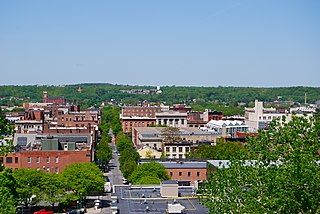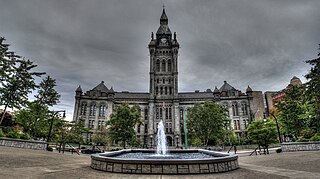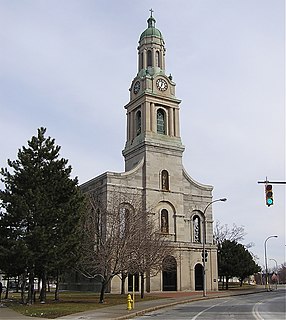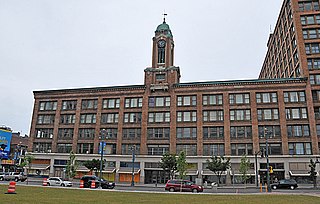
Buffalo City Hall is the seat for municipal government in the City of Buffalo, New York. Located at 65 Niagara Square, the 32-story Art Deco building was completed in 1931 by Dietel, Wade & Jones.

The Allegheny County Courthouse in downtown Pittsburgh, Pennsylvania, is part of a complex designed by H. H. Richardson. The buildings are considered among the finest examples of the Romanesque Revival style for which Richardson is well known.

The Old Post Office, also known as U.S. Post Office, is a historic post office building located at 121 Ellicott Street in Buffalo in Erie County, New York. It is currently home to the City Campus of SUNY Erie.

The First Universalist Church is an historic Universalist church building located at 150 S. Clinton Ave. in Rochester, New York. Construction began in September 1907 and was dedicated in October 1908. First Universalist Church is affiliated with the Unitarian Universalist Association and is one of two Unitarian Universalist congregations in Monroe County, New York; the other being the First Unitarian Church of Rochester.

The Campbell–Whittlesey House, also known as the Benjamin Campbell House, in Rochester, New York is an historic Greek Revival home, designed by architect Minard Lafever. It was built in 1836, and added to the National Register of Historic Places on February 18, 1971.

The Central Troy Historic District is an irregularly shaped, 96-acre (39 ha) area of downtown Troy, New York, United States. It has been described as "one of the most perfectly preserved 19th-century downtowns in the [country]" with nearly 700 properties in a variety of architectural styles from the early 19th to mid-20th centuries. These include most of Russell Sage College, one of two privately owned urban parks in New York, and two National Historic Landmarks. Visitors ranging from the Duke de la Rochefoucauld to Philip Johnson have praised aspects of it. Martin Scorsese used parts of downtown Troy as a stand-in for 19th-century Manhattan in The Age of Innocence.

Schenectady City Hall is the seat of government of the city of Schenectady, New York, United States. Designed by McKim, Mead, and White, the building was constructed between 1931 and 1933. It is located on the block between Clinton, Franklin, Jay and Liberty streets. It is built in a revival of the Federal Style, the dominant style of American architecture from 1780 to 1830. Its most prominent features include the square clock tower, with its gold-leaf dome and weathervane, and the Ionic neoclassical portico. It houses not only city government but the local office of U.S. Rep. Paul Tonko.

County and City Hall, also known as Erie County Hall, is a historic city hall and courthouse building located at Buffalo in Erie County, New York. It is a monumental granite structure designed by Rochester architect Andrew Jackson Warner and constructed between 1871 and 1875, with its cornerstone being laid on June 24, 1872. The building has four floors and features a 270-foot high clock tower.

The Orleans County Courthouse Historic District is one of two located in downtown Albion, New York, United States. Centered on Courthouse Square, it includes many significant buildings in the village, such as its post office and churches from seven different denominations, one of which is the tallest structure in the county. Many buildings are the work of local architect William V.N. Barlow, with contributions from Solon Spencer Beman and Andrew Jackson Warner. They run the range of architectural styles from the era in which the district developed, from Federal to Colonial Revival.

The Genesee County Courthouse Historic District is located at the junction of Main, West Main and Ellicott streets in downtown Batavia, New York, United States. It is a small area with the county courthouse, a war memorial and other government buildings dating from the 1840s to the 1920s. Some were originally built for private purposes.

Ebenezer Watts House is a historic home located at Rochester in Monroe County, New York. It was built between 1825 and 1827 and remodelled in the 1850s. It is a two-story brick structure with a hipped roof and cupola in the Italianate style. It features a Federal style entrance and interior. It is the oldest surviving residence in downtown Rochester.

Jonathan Child House & Brewster–Burke House Historic District is a national historic district containing a set of two historic homes located at Rochester in Monroe County, New York.

First Presbyterian Church is a historic Presbyterian church located at Rochester in Monroe County, New York. It is a Gothic Revival–style edifice designed in 1871 by Rochester architect Andrew Jackson Warner. It is built of Albion sandstone and trimmed with white Medina sandstone. It features a single stone bell tower and spire at the northeast corner beside the main entrance. It was the third home for Rochester's oldest congregation. It is now home to the Central Church of Christ.
Andrew Jackson Warner, also known as A. J. Warner, was a prominent architect in Rochester, New York.

St. Joseph Roman Catholic Church and Rectory was a historic Roman Catholic church and rectory located at 108 Franklin Street, Rochester in Monroe County, New York. The complex was listed on the National Register of Historic Places in 1975. The structure's shell has been preserved as monument after a disastrous fire.

The Old Stone Warehouse in Rochester, New York is a historic warehouse building. It was built in 1822 and is a four-story, trapezoidal building with six story addition built of Medina sandstone. It was built by Myron Holley and was located on the Erie Canal. During the mid 19th century it was used as a foundry.

Powers Building is a historic office building located in Rochester in Monroe County, New York. It was built in 1869 and is a nine-story, 165-by-171-foot building, laid out around a large open stairwell in the center. It features a triple mansard roof and observation tower which were added after initial construction, between 1873 and 1888, by Daniel Powers to maintain its standing as the tallest building in Rochester. It was designed by noted Rochester architect Andrew Jackson Warner.

The Old Post Office and Courthouse is a historic courthouse and former post office located at 157 Genesee Street in Auburn, New York. It was built in 1888–1890 and was designed by the Office of the Supervising Architect of the Treasury Department, Mifflin E. Bell, in the Richardsonian Romanesque style. The limestone-and-brick building was expanded in 1913–1914, designed by James M. Elliot, and again in 1937. It serves as a courthouse of the United States District Court for the Northern District of New York. The massive, asymmetrical, 2+1⁄2-story main block (1888) includes a 3-story tower at the southwest corner, a 2+1⁄2-story stair tower, and two massive Richardsonian Romanesque–style entrances.

The Architecture of Buffalo, New York, particularly the buildings constructed between the American Civil War and the Great Depression, is said to have created a new, distinctly American form of architecture and to have influenced design throughout the world.

Sibley's, Lindsay and Curr Building is a historic commercial building located at Rochester in Monroe County, New York. It was designed by noted Rochester architect J. Foster Warner and built for Sibley's in 1904. The original wing of the building was constructed in 1906 as a five-story, Chicago school style skeletal steel building sheathed in brown Roman brick with deeply set Chicago style windows, topped by a clock tower with Baroque and Renaissance style details. Additions were made to the building in 1911 and 1924, including a 12-story tower section.





























